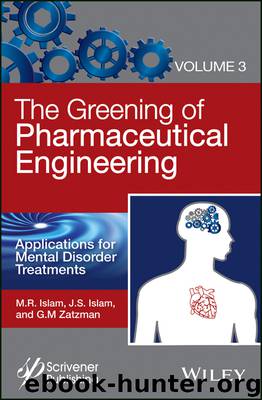The Greening of Pharmaceutical Engineering, Applications for Mental Disorder Treatments by Unknown

Author:Unknown
Language: eng
Format: epub
ISBN: 9781119183822
Publisher: John Wiley & Sons, Incorporated
Published: 2017-07-13T19:21:00+00:00
It is very clear that according to the Qur’an and Prophetic sayings, the cure to depression (the way to untangle the sense of helplessness) is by making a connection to Allah, the caretaker of the entire universe.
There is no scholarly work to our knowledge that addresses the issue of “salah” or the Islamic practices in particular; however, there is a body of literature that looks into yoga and its effect on depression. The root word of yoga, “yuj” in Sanskrit, means union, joining, concentrating of attention. Yoga means union and connection; basically it is the notion of addition, connection or joining of things. Similarly, the word “Salāt” in Arabic means connection, joining; it basically has the same meaning. As discussed in Volume 1 (Islam et al., 2015), yoga has the same notion of Salah, and yoga in practice in ancient Indian times implied connection to “Mahidhara”. The Mahidhara means the holder of the universe. Today, of course, especially with the advent and popularity of yoga in the West, yoga has the meaning of grounding one’s self and connecting essentially to nothing; learning of the mind. Grounding in this case refers to the inner self, increasing awareness of yourself which supposedly helps with several mental health problems.
Figure 5.4 shows how both processes end up achieving the same goal; however, it should be noted that the original yoga allows for the root of the problem of depression to be targeted. In Arabic this is similar to the names of Allah “Rahmān” and Rahīm”. Salāt in practice3 is of course connection to Allah as was explained above. We will examine some literature connecting health benefits of yoga, and connect the overview to the concept of yoga and how it is logical that it helps with stress, anxiety, and depression. Figure 5.4 clarifies this point.
Figure 5.3 shows the difference between the types of yoga, and represents the typical person, whether depressed or not. The person is bound to go through difficulties of life causing them to be affected and distracted; however, it is a very short-term cycle and will inevitably end at death (the box). What real yoga does is allow for the depressed/person in hardship to focus on the much larger and significant external, outside of the box, rather than the small, temporary lines within the box. Modern yoga focuses so much on the straight line (pathway, desires), that the practitioner is isolated from the distractions of life. We hypothesize that the latter way is much more effective as it allows for a person to “latch” onto an external (which targets the key cause of depression) while effectively isolating himself or herself from life’s misfortunes.
Download
This site does not store any files on its server. We only index and link to content provided by other sites. Please contact the content providers to delete copyright contents if any and email us, we'll remove relevant links or contents immediately.
Alchemy and Alchemists by C. J. S. Thompson(3300)
The Elements by Theodore Gray(2856)
The Club by A.L. Brooks(2755)
How to Make Your Own Soap by Sally Hornsey(2746)
Drugs Unlimited by Mike Power(2488)
Wheels of Life by Anodea Judith(1923)
Cracking the Sat French Subject Test, 2013-2014 Edition by The Princeton Review(1768)
Perfume by Jean-Claude Ellena(1742)
The Flavor Matrix by James Briscione(1716)
Cracking the LSAT, 2012 Edition by Princeton Review(1697)
The Cosmic Machine: The Science That Runs Our Universe and the Story Behind It by Scott Bembenek(1693)
MCAT Physics and Math Review by Princeton Review(1570)
1000 Multiple-Choice Questions in Organic Chemistry by Organic Chemistry Academy(1568)
The Thing Around Your Neck by Chimamanda Ngozi Adichie(1490)
Cracking the SAT Premium Edition with 6 Practice Tests, 2017 by Princeton Review(1481)
Handbook of Modern Sensors by Jacob Fraden(1481)
Synchrotron Light Sources and Free-Electron Lasers by Eberhard J. Jaeschke Shaukat Khan Jochen R. Schneider & Jerome B. Hastings(1461)
A is for Arsenic: The Poisons of Agatha Christie (Bloomsbury Sigma) by Kathryn Harkup(1458)
Harry Potter All Books: 8 Books by J.k.rowling(1438)
